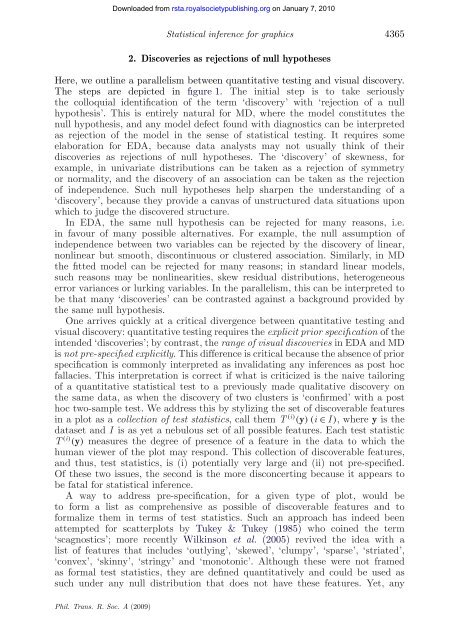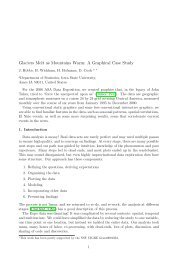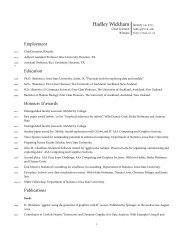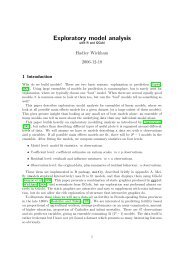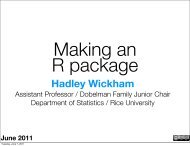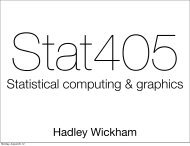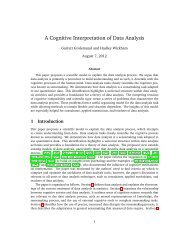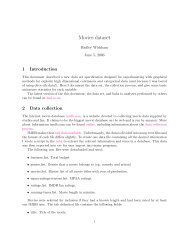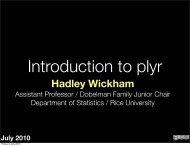Statistical inference for exploratory data analysis ... - Hadley Wickham
Statistical inference for exploratory data analysis ... - Hadley Wickham
Statistical inference for exploratory data analysis ... - Hadley Wickham
You also want an ePaper? Increase the reach of your titles
YUMPU automatically turns print PDFs into web optimized ePapers that Google loves.
<strong>Statistical</strong> <strong>inference</strong> <strong>for</strong> graphics 4365<br />
2. Discoveries as rejections of null hypotheses<br />
Here, we outline a parallelism between quantitative testing and visual discovery.<br />
The steps are depicted in figure 1. The initial step is to take seriously<br />
the colloquial identification of the term ‘discovery’ with ‘rejection of a null<br />
hypothesis’. This is entirely natural <strong>for</strong> MD, where the model constitutes the<br />
null hypothesis, and any model defect found with diagnostics can be interpreted<br />
as rejection of the model in the sense of statistical testing. It requires some<br />
elaboration <strong>for</strong> EDA, because <strong>data</strong> analysts may not usually think of their<br />
discoveries as rejections of null hypotheses. The ‘discovery’ of skewness, <strong>for</strong><br />
example, in univariate distributions can be taken as a rejection of symmetry<br />
or normality, and the discovery of an association can be taken as the rejection<br />
of independence. Such null hypotheses help sharpen the understanding of a<br />
‘discovery’, because they provide a canvas of unstructured <strong>data</strong> situations upon<br />
which to judge the discovered structure.<br />
In EDA, the same null hypothesis can be rejected <strong>for</strong> many reasons, i.e.<br />
in favour of many possible alternatives. For example, the null assumption of<br />
independence between two variables can be rejected by the discovery of linear,<br />
nonlinear but smooth, discontinuous or clustered association. Similarly, in MD<br />
the fitted model can be rejected <strong>for</strong> many reasons; in standard linear models,<br />
such reasons may be nonlinearities, skew residual distributions, heterogeneous<br />
error variances or lurking variables. In the parallelism, this can be interpreted to<br />
be that many ‘discoveries’ can be contrasted against a background provided by<br />
the same null hypothesis.<br />
One arrives quickly at a critical divergence between quantitative testing and<br />
visual discovery: quantitative testing requires the explicit prior specification of the<br />
intended ‘discoveries’; by contrast, the range of visual discoveries in EDA and MD<br />
is not pre-specified explicitly. This difference is critical because the absence of prior<br />
specification is commonly interpreted as invalidating any <strong>inference</strong>s as post hoc<br />
fallacies. This interpretation is correct if what is criticized is the naive tailoring<br />
of a quantitative statistical test to a previously made qualitative discovery on<br />
the same <strong>data</strong>, as when the discovery of two clusters is ‘confirmed’ with a post<br />
hoc two-sample test. We address this by stylizing the set of discoverable features<br />
in a plot as a collection of test statistics, call them T (i) (y)(i ∈ I ), where y is the<br />
<strong>data</strong>set and I is as yet a nebulous set of all possible features. Each test statistic<br />
T (i) (y) measures the degree of presence of a feature in the <strong>data</strong> to which the<br />
human viewer of the plot may respond. This collection of discoverable features,<br />
and thus, test statistics, is (i) potentially very large and (ii) not pre-specified.<br />
Of these two issues, the second is the more disconcerting because it appears to<br />
be fatal <strong>for</strong> statistical <strong>inference</strong>.<br />
A way to address pre-specification, <strong>for</strong> a given type of plot, would be<br />
to <strong>for</strong>m a list as comprehensive as possible of discoverable features and to<br />
<strong>for</strong>malize them in terms of test statistics. Such an approach has indeed been<br />
attempted <strong>for</strong> scatterplots by Tukey & Tukey (1985) who coined the term<br />
‘scagnostics’; more recently Wilkinson et al. (2005) revived the idea with a<br />
list of features that includes ‘outlying’, ‘skewed’, ‘clumpy’, ‘sparse’, ‘striated’,<br />
‘convex’, ‘skinny’, ‘stringy’ and ‘monotonic’. Although these were not framed<br />
as <strong>for</strong>mal test statistics, they are defined quantitatively and could be used as<br />
such under any null distribution that does not have these features. Yet, any<br />
Phil. Trans. R. Soc. A (2009)<br />
Downloaded from<br />
rsta.royalsocietypublishing.org on January 7, 2010


